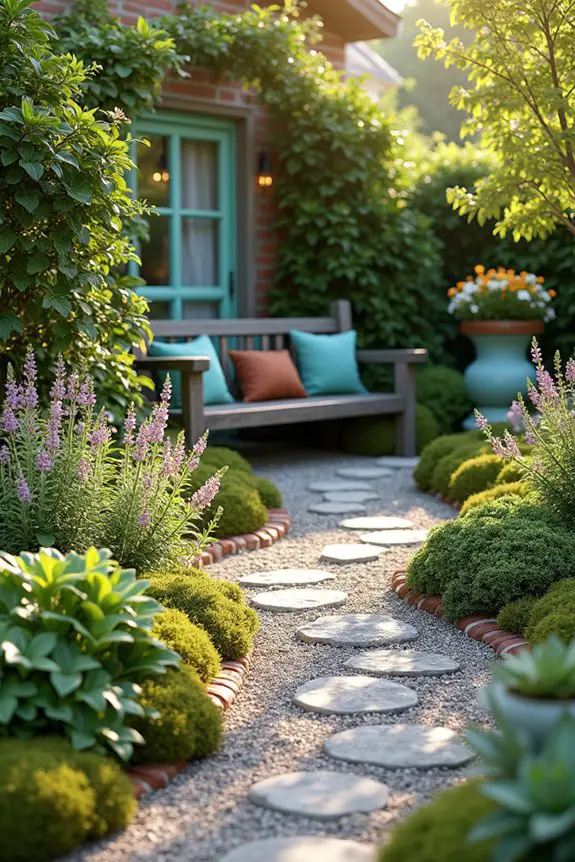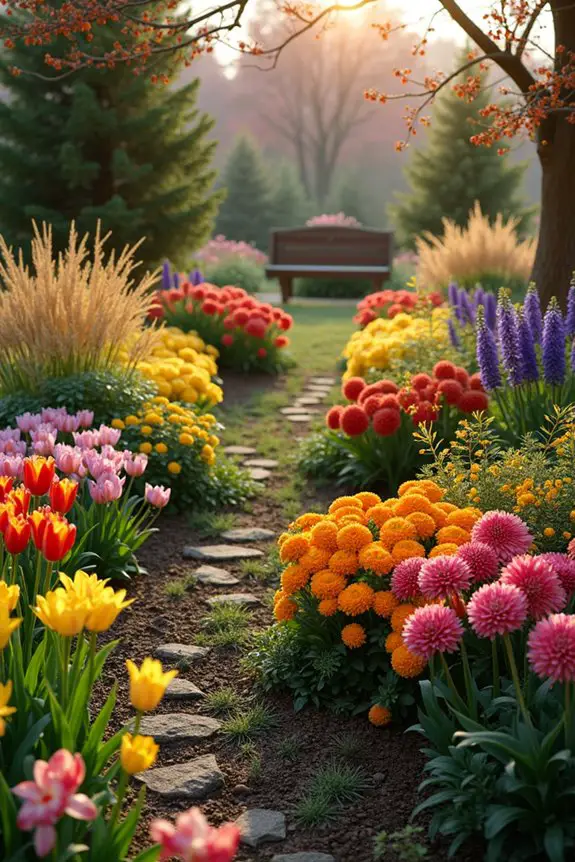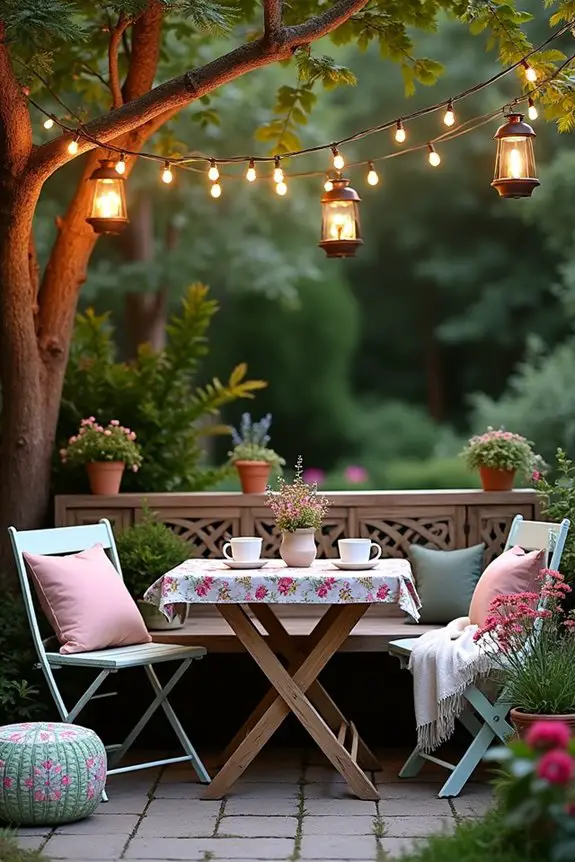Let’s just say, sprucing up your front garden can sometimes be a tall order. But fear not, it doesn’t have to be overwhelming. Imagine stepping out to a colorful garden, bursting with life right at your doorstep. You might wonder, how do you turn that patch of earth into something magical? From cozy paths to eye-catching vertical displays, you’ll find ideas that not only make your space shine but also reflect your unique style.
Charming Cottage-Style Gardens
If you’ve ever dreamed of stepping into a whimsical garden straight out of a storybook, a charming cottage-style garden might be your ticket.
Imagine colorful flower beds greeting you, pathways winding like a friendly chat, and maybe even a picket fence framing it all—how delightful!
Plus, blending in some edible plants adds a sprinkle of fun; who wouldn’t love snipping fresh herbs right from their front yard?
1. Garden Path Layout
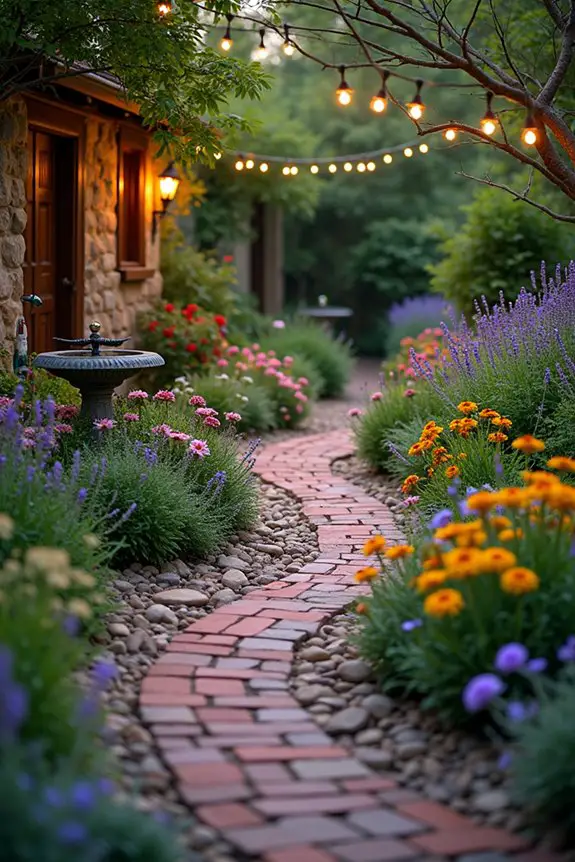
When designing a charming cottage-style garden, one of the most delightful features to contemplate is the garden path layout. Envision it as the welcome mat to your home, guiding guests through a whimsical journey filled with blooms and greenery. Not only does a well-planned path look good, but it also serves the functional purpose of leading the way, avoiding muddy shoes during rain or garden maintenance.
So, what’s this path all about? Imagine winding stones or bricks (maybe even reclaimed wood) creating a cozy trail that invites you to stroll right into your garden. You can use different materials to add texture and interest. Maybe you’ve got some old bricks lying around? Perfect use for those! Or, perhaps you opt for smooth river stones. Just be sure to lay them down flat—tripping over a rock isn’t quite the cottage charm we’re aiming for.
Now, for a touch of magic, think about softening the path with some low-growing plants. A few tufts of thyme or creeping phlox can peek out from between the stones, filling the area with sweet fragrances. Picture this: you’re walking along, the smell of mint wafting up to greet you—talk about a garden that gets you excited when you step outside!
Don’t forget about curves; they’re the secret ingredient to a delightful path. Straight lines can feel a bit stiff—like a strict math teacher, right? A serpentine design mimics nature’s flow and makes your garden feel more inviting. It also creates little nooks and surprises where you might place a whimsical garden gnome or a charming birdbath. Trust me; you’ll want those little moments to discover as you walk.
Last but not least, lighting adds a whole new dimension to your garden path. String lights, lanterns, or even solar path lights can create a cozy evening escape. Imagine sipping tea on the porch, the soft glow guiding your eyes through the blooming delight.
2. Colorful Flower Bed Arrangement
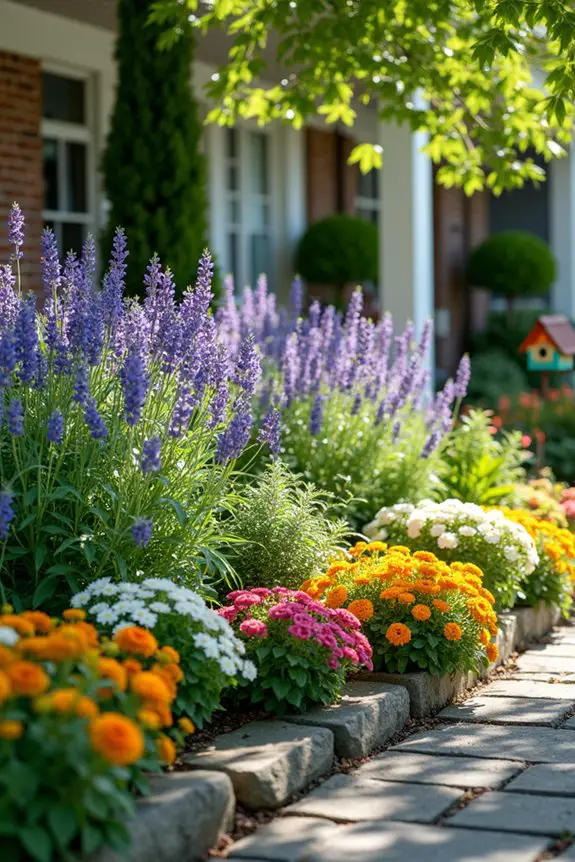
Creating a colorful flower bed arrangement is like preparing a delicious dish—it’s all about the right ingredients and a dash of flair. This setup not only enhances the beauty of your front garden but also invites feelings of joy and warmth. Imagine stepping outside and being greeted by a burst of colors, all working together to create a peaceful little paradise right at your doorstep.
First things first, choose your flowers based on colors and blooming seasons. Mixing perennials and annuals can give you that continuous pop throughout the year. Think of daisies, marigolds, and lavender—each flower has its personality and blooms differently. Picture a sunny yellow marigold standing tall beside deep purple salvia. They create a delightful contrast that can make any passerby stop and admire. Yes, the neighbors will definitely be a little envious.
Next, consider varying your plant heights for a three-dimensional look. Taller plants in the back, medium in the middle, and the petite ones at the front; it’s like designing a stage for a play. That way, every flower gets its moment in the spotlight. If you’ve got a hydrangea bush in the back, it can be the diva surrounded by lovely companions. Additionally, incorporating a plant humidity tray can support healthier plants by providing consistent moisture.
And remember, don’t be shy to get a little messy. Nature isn’t about perfection, it’s about beautiful chaos. To ensure optimal growth, consider using a humidity dome for seedlings to protect young plants and promote a healthy environment.
Don’t forget to include some foliage plants too. Green leaves create a lovely backdrop, allowing the colorful blooms to truly shine. Variegated hostas, ferns, or even ornamental grasses can add texture and height, making your flower bed feel complete.
Just be cautious with those grass clippings. Ahem, I may or may not have learned the hard way that too much grass can drown your flowers—it’s all about balance folks!
Lastly, finishing touches like garden edging or decorative stones can bring the whole arrangement together. A simple border can frame your flower bed like a picture in a gallery, giving it that polished look while keeping mulch in check.
Plus, if you throw in a few whimsy items like a small birdhouse or a funky garden stake, you’ll have your own little enchanted spot right outside.
3. Vertical Planting Features
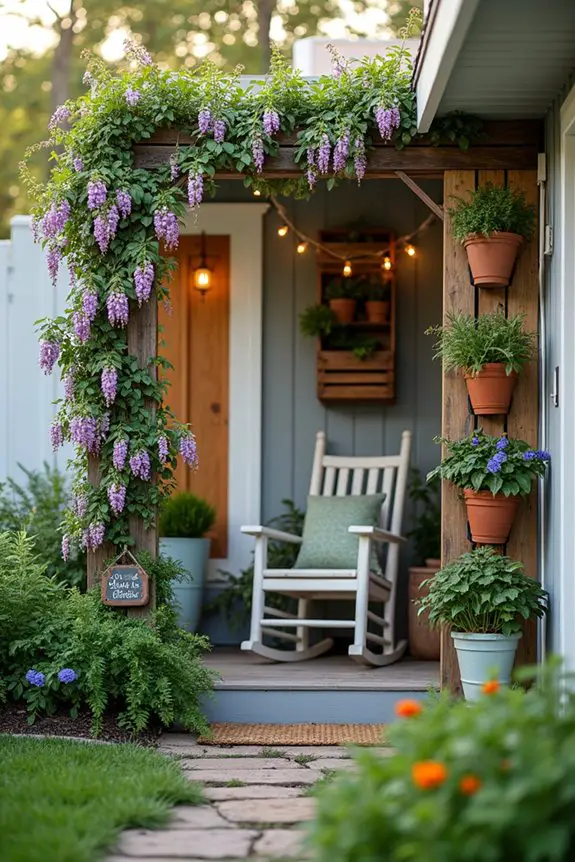
When you’re working with a small front garden, vertical planting features can be a game changer. Not only do they save precious ground space, but they also add charm and character that instantly elevates your garden vibe. Think of it as giving your plants a cozy apartment in the city—everyone needs their space to flourish, right?
One of the best ways to introduce vertical elements is through trellises. They’re like the perfect party hosts, allowing climbing plants like sweet peas, jasmine, or even cucumbers (yes, you can grow veggies in your front garden!) to reach for the sky while saving floor space. Imagine walking up to your home and being greeted by a lush green wall, or better yet, sweet-smelling blooms cascading down from above. You might wonder, how do I even start?
Begin by selecting a sturdy trellis that complements your garden style. Go for weathered wood for that rustic, cottage feel, or sleek metal for a more modern touch. Once you have your trellis in place, pair it with the right climbing plants. Start small—maybe just one or two climbing plants that can fill the trellis over time. It’s like introducing new friends to gradually expand your social circle; too many at once can lead to chaos.
Don’t forget about wall planters too. These beauties can hold herbs, succulents, or even flowers, and they give your garden a sophisticated edge. Hanging pockets or tiered shelves can display your favorite plants like little trophies. Furthermore, a vertical garden wall planter can transform any wall into a stunning display of greenery, making your garden truly stand out.
And trust me, it feels fantastic to grow your own herbs right outside your front door. Plus, fresh basil for your pasta? Yes, please.
If you feel a bit adventurous, you could even create a vertical garden using pallets or wooden crates. Stack them up against a sunny wall, fill them with soil, and plant a mix of flowers and herbs. It’s a delightful DIY project that not only looks great but is also incredibly rewarding.
Just maybe don’t invite your clumsy friends over when you’re constructing it; I still have a pallet-shaped dent in my garden from my attempt at a vertical herb display—who knew nails could be so slippery?
Incorporating vertical planting features brings a whimsical cottage feel to your front garden, where space is limited but creativity is boundless. So, embrace the up rather than the out, and watch your vertical garden bloom into a cozy wonderland for all to admire.
4. Picket Fence Integration
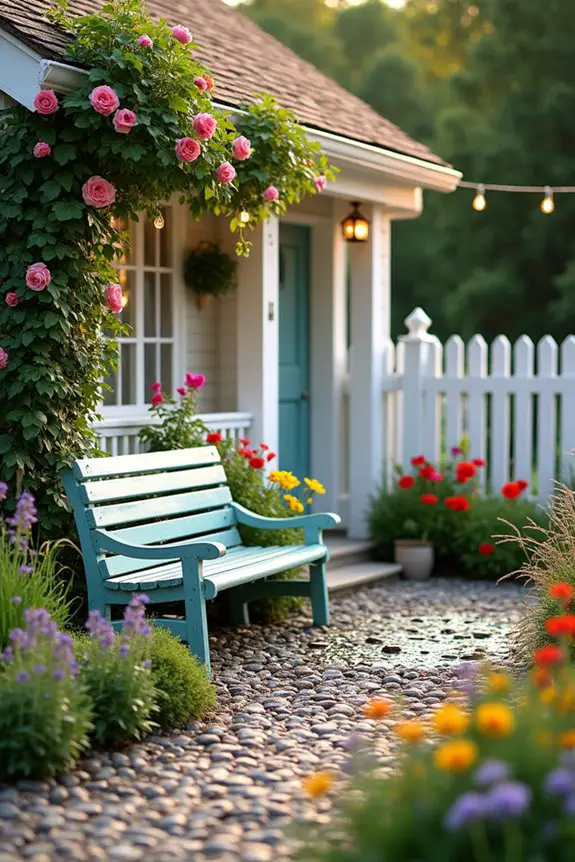
When thinking about sprucing up your front garden, integrating a picket fence is like adding the icing on a beautifully baked cake. Not only does it serve as a charming boundary, giving your garden a cozy, enclosed feel, but it also adds that quintessential cottage vibe we all adore.
Just picture it: a quaint white picket fence, a riot of colorful blooms spilling over, and a warm, inviting atmosphere calling for afternoon tea in the sun. The magic begins with the fence itself.
Depending on your style, you might opt for classic white wood for that timeless look, or choose a vibrant color that complements your home. It’s like dressing up your garden in its Sunday best. If you’re feeling inspired, consider attaching climbing plants or delicate fairy lights to your picket fence. A garden water feature can also enhance the soothing ambiance with the gentle sounds of flowing water.
It’s all about creating a welcoming entrance—like rolling out the welcome mat for friends and neighbors alike. Installing a picket fence is easier than you might think. Picket fence panels are a popular choice and can enhance the overall aesthetic of your garden space.
Start by measuring out your desired area. Don’t worry; it’s not as complicated as trying to assemble a piece of IKEA furniture without the instructions. Once you’ve got your measurements, gather your materials and mark where each post will go.
Think of it as placing little seeds in the ground; they all have to be in the right spot to bloom beautifully. Digging post holes can be a workout—seriously, I might as well have signed up for a gym membership instead of undertaking my own fence project.
But with a little effort and determination, you’ll get those posts in and secured. It’s essential to make sure they’re straight; no one wants a fence that bows like a tired willow tree under pressure. Then, just attach the pickets based on your preferred spacing.
Once your fence is up, it’s time for the fun part—decorating! Add some climbing plants for a dash of life or hang whimsical decor to reflect your personality.
Trust me, there’s nothing like the feeling of stepping back and seeing your vision come to life right before your eyes.
5. Edible Plant Integration
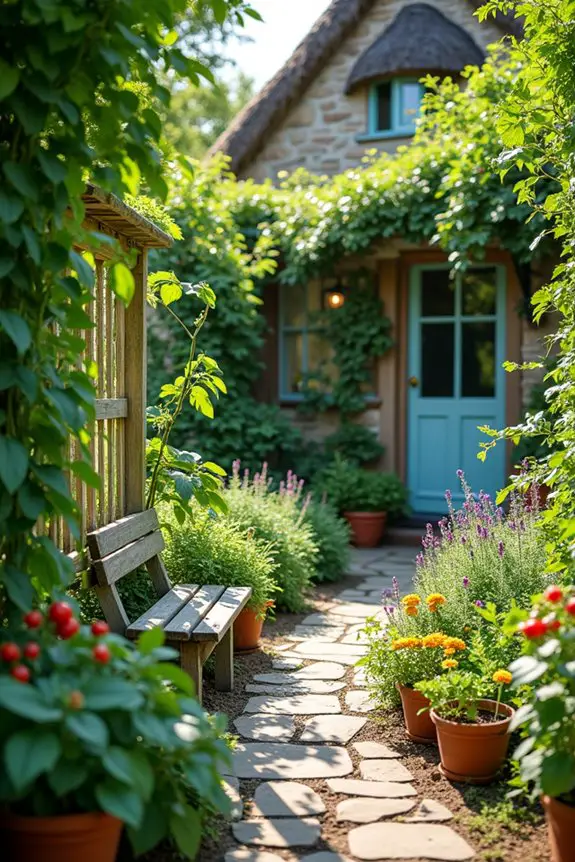
When it comes to charming cottage-style gardens, integrating edible plants is a delightful option. Imagine strolling through your little slice of heaven, plucking fresh herbs or juicy cherry tomatoes right from the vine. Not only does this add a functional twist to your garden, but it also gives off that warm, homey vibe we all crave. It’s like having your very own farmers’ market just steps away from your door.
To start, think about what you love to cook with—basil for that perfect pasta dish? Or perhaps strawberries to enjoy in your morning smoothies? Choose plants that not only look appealing but also make your taste buds happy. You can even jar homemade sauces or preserve fruits to share with family and friends. It’s not just a garden; it’s a space for memories, laughter, and maybe even a cooking lesson or two.
Now, here comes the fun part: planting. Drop those seeds or seedlings into well-prepared soil, making sure to space them out like your garden is throwing a socially distanced party. Each plant needs its room to grow and thrive. If you have a small garden, consider vertical gardening. You can use trellises or wall planters to maximize space while still keeping it cozy and inviting. Trust me, plants like peas or cucumbers will feel right at home crawling up a trellis.
As your plants grow, don’t forget to give them a little love—water them regularly and talk to them (yes, plants really do respond to kind words). You might feel silly, but you’ll find a certain joy in nurturing them. Remember, gardening is a journey; every sprout and flower is a small victory worth celebrating.
And when harvest time comes, picking fresh produce will be like finding the secret ingredient you didn’t even know you were missing. Who wouldn’t want to feel like a kitchen magician plucking an herb straight from the garden?
6. Natural Stone Pathways
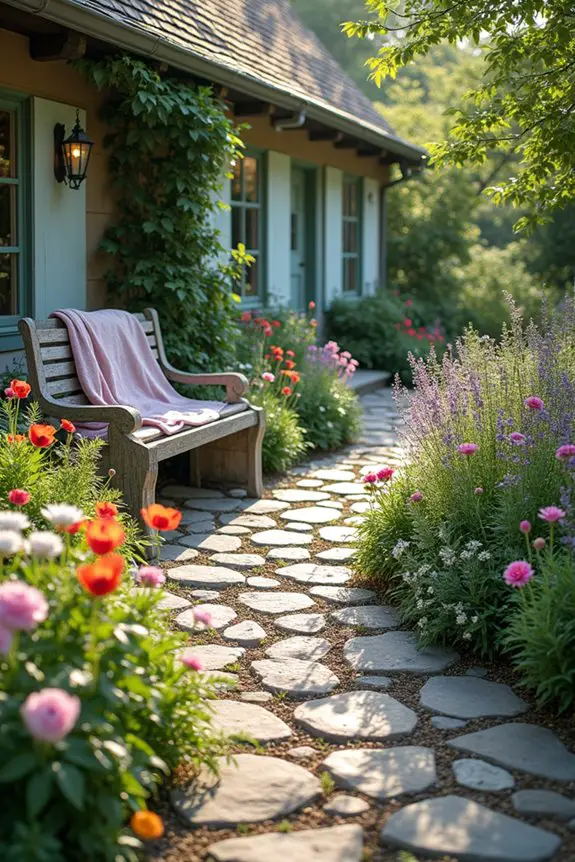
When it comes to creating a charming cottage-style garden, natural stone pathways can make all the difference. Not only do they offer a rustic, inviting feel that whispers “come take a stroll,” but they also provide functionality, guiding guests through your little paradise without trampling on your blooms.
Think of it as laying down a warm welcome mat from nature that enhances the beauty of your garden and highlights those delightful plants you’ve been nurturing.
To start, choose stones that complement your garden’s vibe—think about earthy tones or weathered stones that tell a story. You might love the look of flat, wide stones for a more traditional feel, or perhaps you’re drawn to the rugged charm of irregular shapes that add a playful twist.
Whichever stones you pick, imagine walking along them as you gather fresh herbs for dinner. Isn’t that picture perfect?
Once you’ve got your stones, lay them out on the ground in a pattern that feels natural, as if Mother Nature herself arranged them. Consider spacing them so you can fit your shoe comfortably, because believe me, the last thing you want is to stub your toe on an unexpected sharp edge.
Start by marking the path lightly with a garden shovel or a small spade, then clear the area of grass and weeds, making way for your stony masterpiece.
Next, add a layer of sand or gravel as a base for stability. It’s like laying the foundation for a mini castle—every great pathway needs one.
Place the stones down gently but firmly, giving them a little wiggle to guarantee they’re settled just right. You’ll want them to sit nicely without wobbling when you take your evening stroll.
Finally, fill in the gaps with dirt, gravel, or creeping plants to create that enchanting vibe that a cottage garden is all about. Imagine tiny flowers peeking between the stones, inviting little bees and butterflies to join your garden’s party.
Each time you walk the path, you’ll feel that warm embrace of nature, making your garden not just a sight to behold, but an experience to cherish.
And maybe, on those cozy evenings when you manage to dodge the weed-pulling, you’ll find yourself taking a stroll just for the joy of it. Now, who wants to join?
7. Seasonal Plant Selection Strategy
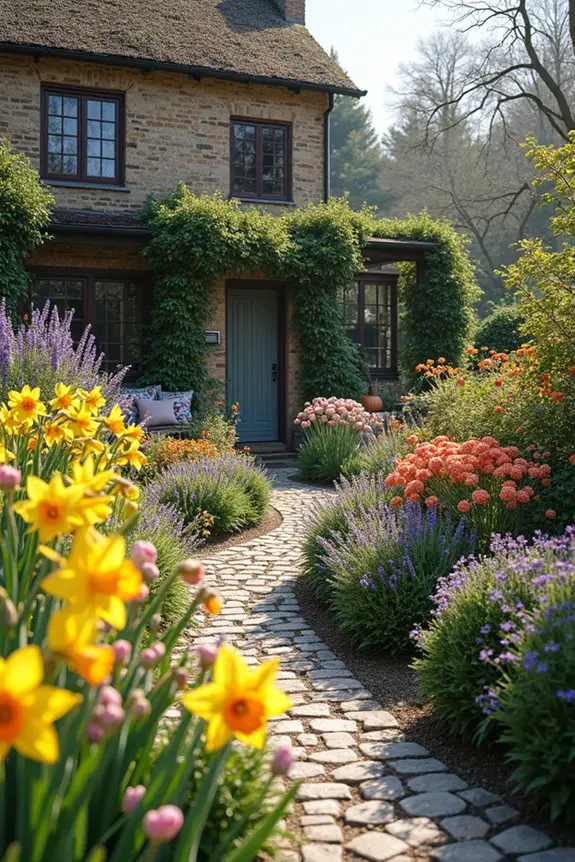
When planning a charming cottage-style garden, choosing the right seasonal plants can truly elevate the atmosphere and guarantee your garden flourishes in every season.
Think of it as dressing your garden in a new outfit, with each season showcasing different colors, shapes, and fragrances that keep things fresh and exciting. This approach not only boosts the aesthetic appeal but also supports the local ecosystem and makes your outdoor space feel alive year-round.
Start by making a seasonal calendar of plants that thrive in your area. In spring, vibrant tulips, daffodils, and hyacinths can create a stunning display, while summer might call for dazzling sunflowers, zinnias, or lavender swaying gently in the breeze.
Fall provides a perfect opportunity for golden chrysanthemums, ornamental kale, or the playful touch of pumpkins. And don’t let winter dampen your spirits — consider planting evergreens or winterberry holly to maintain some life and color during the cold months.
Have you ever looked out at a snowy garden and thought, “Oh, I could use some color here”? Trust me, it helps.
As you curate your selection, think about bloom times and layering your plants like you’re creating a delicious lasagna. Tall plants can stand at the back, with medium ones in the middle, and shorter varieties at the front.
This not only gives your garden depth but also guarantees all your lovely flowers get the sunshine they crave. Remember, even the tallest sunflowers have to know their place.
One of my favorite tricks is to incorporate fragrant herbs, such as thyme or rosemary, amidst your flowers. Not only do they smell delightful, but they also serve practical purposes, like attracting pollinators and adding that chef-approved touch to your kitchen, too.
Who doesn’t love a little fresh rosemary for their roasted chicken?
Finally, don’t forget to sprinkle in some perennials that will return year after year, creating a harmonious balance with your annuals. It’s like building a family recipe book — you want reliable staples that never disappoint.
This way, every season becomes an invitation to step into a beautiful, different world, full of surprises and growth, without the need for a lot of extra effort.
Picture yourself sipping tea surrounded by beauty and life, isn’t that dreamy? So, grab your gardening gloves, make your list, and let’s get planting. Your charming cottage garden awaits.
8. Garden Lighting Techniques
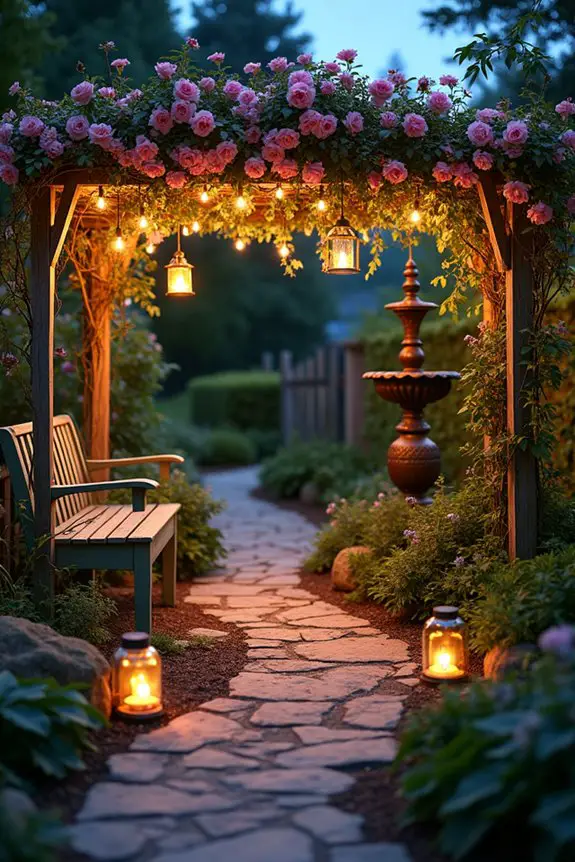
When it comes to designing a charming cottage-style garden, lighting can transform your little paradise into a magical retreat. Imagine twinkling fairy lights strung between trees or the soft glow of lanterns lining your paths — it’s like bringing the stars down to Earth, only without the pesky travel arrangements. Good lighting doesn’t just set the mood; it also highlights all the hard work you’ve put into your plants, making your garden shine, even after the sun sets.
Begin with the basics: choose the right kind of lighting for your needs. If you want to create a warm, inviting ambiance, consider using string lights. You can drape them around a quaint trellis or along a fence. They’re perfect for evening garden parties or a cozy night spent with a good book. And let’s face it, who doesn’t want to feel a little like they’re living in a fairytale?
Next, think strategically about your pathways. Solar-powered path lights are an easy and worry-free way to keep walking areas bright and safe. They’ll charge during the day from the sun and glow beautifully at night, guiding your way like little guardians. The best part? You won’t have to fuss with wires or extension cords, which is a huge bonus if you’re anything like me, often getting stuck in a mess of tangled cords.
Don’t forget about spotlighting! By directing lights onto key features, like a beautiful fountain or a particularly spectacular plant, you can draw attention to what makes your garden special. Just think of it as showcasing the stars of your garden—no agent or audition required. I remember highlighting my favorite climbing rose with a soft spotlight; it felt like my rose was blushing in the spotlight (and maybe it was).
Lastly, let’s sprinkle in a touch of whimsy. Old jars or bottles can be transformed into charming lanterns. Whether you fill them with candles or tiny solar lights, they add a personal touch and a hint of nostalgia, as if telling a story. Believe me; they bring character to your garden that store-bought items just can’t replicate.
9. Harmonious Color Palette Selection
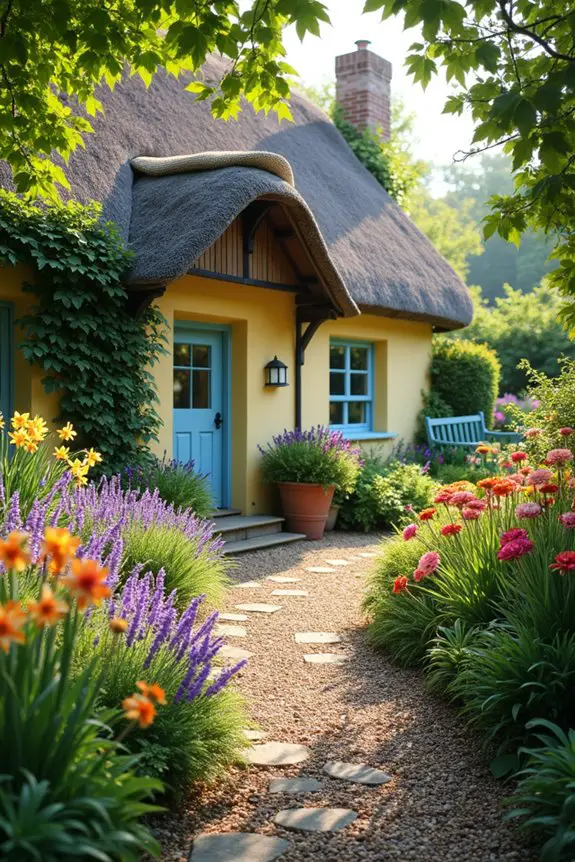
When it comes to creating a charming cottage-style garden, selecting a harmonious color palette is absolutely key. Think of it as setting the mood before you even step foot into your leafy enclave. A well-chosen color scheme not only unifies the space but also enhances its welcoming vibes, making it feel like a cozy retreat where you can truly relax.
Start by considering the colors of your home. Is it a soft cream, a gentle sage green, or perhaps a sweet lavender? Use these hues as your starting point. For instance, if you have a light yellow cottage, pairing it with rich purple flowers can create a stunning contrast that draws the eye and fills the space with vibrancy. You’re fundamentally painting with nature, so think of flowers, foliage, and even decorative elements like pots and furniture as part of your color palette.
Next, limit your palette to about three to five key colors. This keeps things from looking chaotic. Too many colors can feel overwhelming, like a kid in a candy store who can’t quite decide on just one treat. Stick to a mix of bold and soft tones to keep interest while maintaining some harmony.
I’ve made the mistake of going overboard in the past—my neighbor must have thought I was trying to recreate a circus tent right in my backyard!
Consider blooming times too. Combine early spring blooms, like cheerful daffodils, with summer stalwarts, such as vibrant zinnias, to guarantee there’s always something in full swing. This will keep your garden lively throughout the seasons. Plus, you’ll never have to face the dread of a barren garden—no one wants that sad look in their yard.
Lastly, don’t shy away from textures. Pairing flowers with different leaf shapes and surfaces can add depth to your color palette. Imagine the soft, feathery leaves of lamb’s ear next to bold sunflowers; it’s a conversation that shouts, “Look at me!” while remaining totally charming.
In a nutshell, selecting a harmonious color palette is more than just picking pretty shades; it’s about weaving them together to create a garden that feels like a warm hug. Trust me, once you find your perfect hues, your cottage garden will feel less like an ensemble trying to find its rhythm and more like a melody that dances beautifully through the seasons.
10. Texture Variation in Surfaces
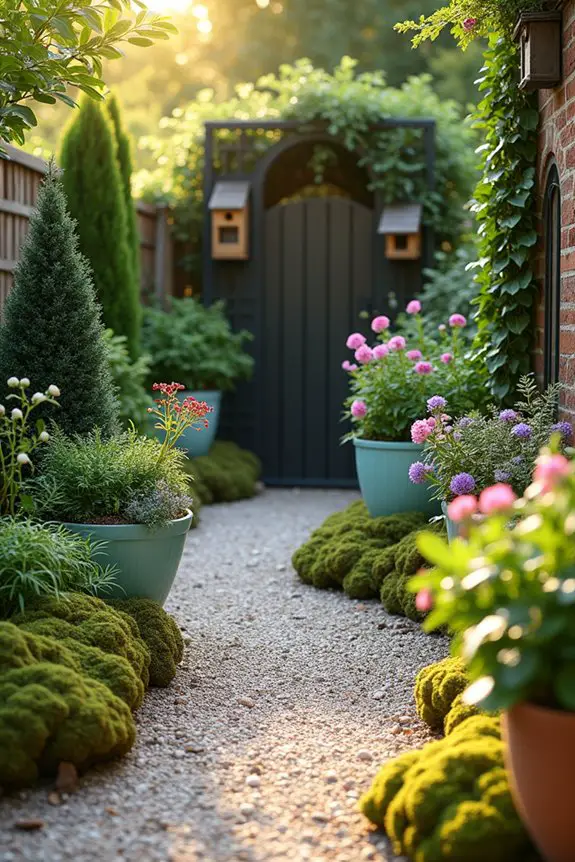
When it comes to charming cottage-style gardens, texture variation in surfaces adds a delightful layer of interest. Just envision it: a garden that features different textures feels alive and dynamic, encouraging the eye to wander and explore. It creates a cozy atmosphere, inviting you to sit down with a book (and perhaps a cup of tea) while you soak up the beauty around you.
Start with the ground. A gravel pathway mixed with soft, mossy patches can add both functionality and charm. Just imagine this: you’re walking on that crunching gravel, which feels nice underfoot, and then you pause to admire those lush green patches that look like nature’s carpet. It’s both practical (goodbye, mud mess during rain!) and visually appealing.
Next, introduce varying materials for your garden borders. Perhaps you could use rustic wooden sleepers on one side and charming brick on the other. They create a visual contrast that keeps the eye engaged and signals different zones in your garden—perfect for setting the scene.
And let’s be honest, a mix of materials tells a story. My neighbor even joked that my garden was like a book with different chapters, each telling its own tale.
Don’t forget about the plants themselves! Mixing tough-leaved evergreens with delicate flowering plants creates a conversation (yes, plants can chat too) that adds depth. Imagine the smoothness of succulents next to the airy, God-given wonder of ferns—it’s like inviting the cool kids to join your garden party.
And those textures can evoke feelings, making you feel calm, inspired, or maybe even a bit whimsical, depending on how you arrange them.
Consider incorporating decorative elements like sculptures, pots, or even trellises made of different materials. A sleek metal trellis next to a rustic wooden birdhouse can add unexpected surprise that breaks up the flow.
I once mixed a modern teal pot beside a weathered clay one, and believe me, the vibrance was delightful, even if my sister asked if I’d lost my marbles. But hey, a little playfulness never hurt anyone, right?
Space-efficient Container Gardening
If you’ve ever looked at a tiny garden space and thought, “There’s no way I can make this work,” you’re definitely not alone.
But don’t count yourself out just yet. Space-efficient container gardening is a game-changer for small front garden ideas. Imagine this: colorful pots lined up along your walkway, each bursting with blooms or tasty herbs. Choosing a variety of heights and colors adds visual interest.
Space-efficient container gardening transforms small front gardens into vibrant displays of color and life.
Go for vertical gardening too; think shelf-like structures where you can stack pots. And let’s be honest, who doesn’t love a good succulent? Low-maintenance and adorable.
Feeling overwhelmed? Start small—pick a few containers and build from there. Soon your tiny oasis will become the envy of the neighborhood, or at least your cat.

